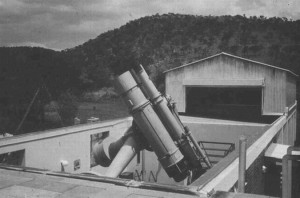Twin RockefellerTwo identical 16 inch (40cm) telescopes Note: Not to be confused with the Rockefeller 60-inch telescope at Boyden Observatory. |
Index:
Summary; History; Current; Technical; Sources; Links; Gallery:
In brief
Important Contributions:
Description:
• In 1929 Willem de Sitter, Director of Leiden University Observatory, commissioned Grubb Parsons (legally ‘Sir Howard Grubb, Parsons and Co. Ltd.’) to build a specialized telescope for observing double stars in the southern sky at the Leiden Southern Station according to the following specifications set by Enjar Hertzsprung:
”It should be a double photographic telescope, having triplet lenses of the Cooke-type, apertures of 40 cm (16 inches) and focal lengths of 229 cm (90 inches), provided with objective prisms and various other auxiliaries. The two identical telescopes should be parallel to each other on the same mounting.”
• Funding of $60,000 was provided by the Rockefeller foundation. These funds were augmented by a donation from Leiden Sterrewacht.
• The aperture ratio of 5.7 was quite demanding, and Hertzsprung had also stipulated that the lenses should have high transmission down to 390 mm wavelengths (near ultraviolet).
• The lenses provided by Grubb Parsons were unable to meet these demanding specifications and new lensers were ordered from Zeiss in Jena.
• The telescopes were delivered to South Africa in 1938 and the Union government built a special observatory building for Leiden to house it.
• The intervention of World War II delayed delivery of the Zeiss lenses until 1949 and during the intervening decade the Cooke-type lenses provided by Grubb Parsons were used as a compromise.
• During the late 1940s Theodor Walraven began developing photoelectric photometry for the astrograph among other instruments, and the astrograph was devoted to a large programme of photoelectric photometry of pulsating variables of the Delta Cepheid type by Walraven, Muller, and Oosterhoff.
• By the 1950s light pollution from the growing city impaired observation in Johannesburg and the telescope was moved to the new Leiden Southern Station at Hartbeespoort in 1957.
• At the same time, a new Flux Collector telescope was installed at Hartbeespoort, and the Rockefeller twin astrograph was only used occasionally thereafter.
Historical Background
Owners:
- Leiden Observatory: 1938 – 1978
- C.S.I.R. 1978-1987.
• Department of Education (Pretoria Technikon and current Tshwane University of Technology)
Where Located:
- Republic Observatory: 1938 – 1957
- Hartebeespoort 1957 – present
Current Information
Present Location:
Toppieshoek Adventure Campsite, Tshwane University of Technology, Toppieshoek Road, Hartbeespoort, Broederstroom, 0216.
Owner:
Tshwane University of Technology.
Status:
Unused, but subject to a restoration project led by the Magaliesberg Association for Culture and Heritage.
Condition:
In need of restoration and re-wiring.
Technical Details
Type: Refractor – Twin telescopes.
Aperture: 16 inch (40.6 cm)
Focal Length: 90 inch (229cm)
Lens: Zeiss
Mounting:
Attachments: Photometers developed by Dr. Walraven.
Manufacturer: Grubb Parsons & Co., Newcastle on Tyne
Sources
Link to the Main Bibliography Section and more information about Sources.
Documentation:
Pictorial Sources:
- Moore, P. & Collins, P., Astronomy in Southern Africa, p.108, p.109.
Bibliography:
- Moore, P. & Collins, P., Astronomy in Southern Africa, p.102, p.107. (General Source)
- Pel, J.W. Pers. comm. 2023.
- Schoenmaker, A.A. “De Rockefeller dubbele astrograaf van het Leids Zuidelijk Station” Sterrewacht Leiden (unpublished manuscript, 1981)
- Smits P. A Brief History of Astronomy in Southern Africa. (Unpublished)
- Vermeulen, D.J. Living amongst the stars at the Johannesburg Observatory. Johannesburg: Chris Van Rensburg Publications, 2006.
Acknowledgement:
Many thanks to Jane and Vincent Carruthers who helped to research and write this page.
Links
Gallery

The 16 inch Rockefeller twin astrograph at Leiden Southern Station, Hartebeespoort.
Photo Credit: David Stevenson. Source: Moore.
